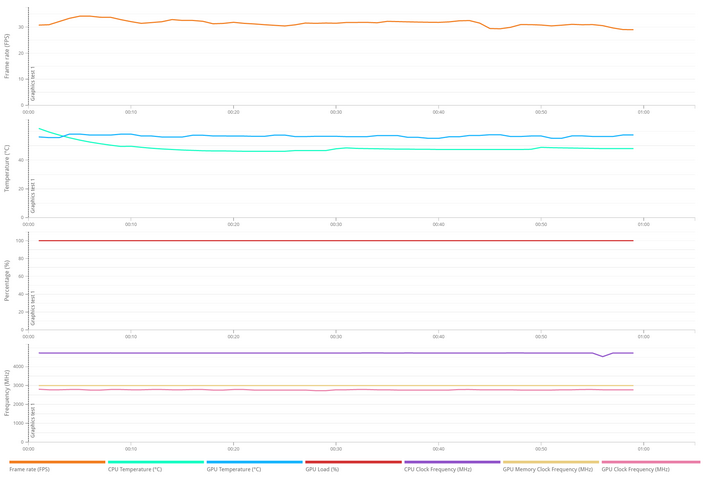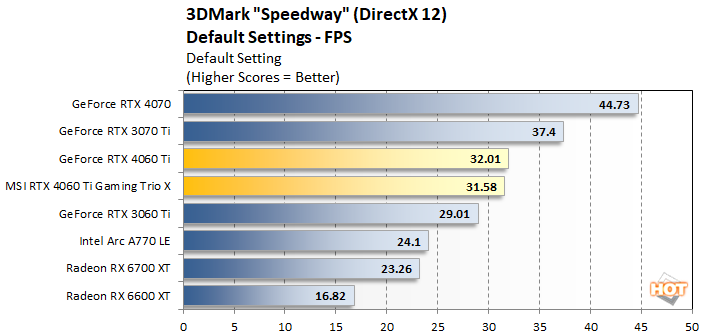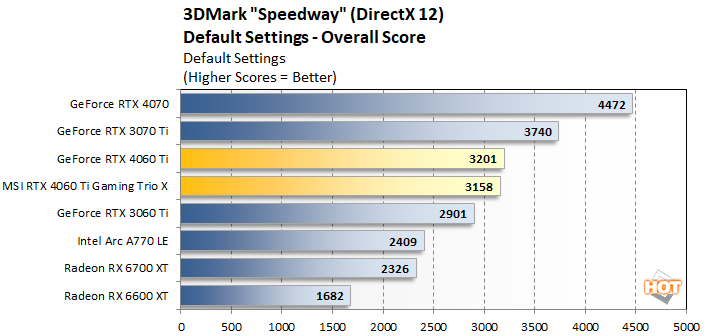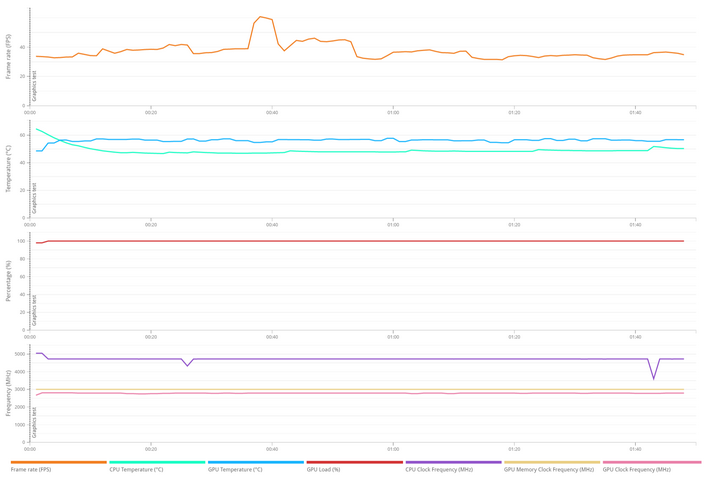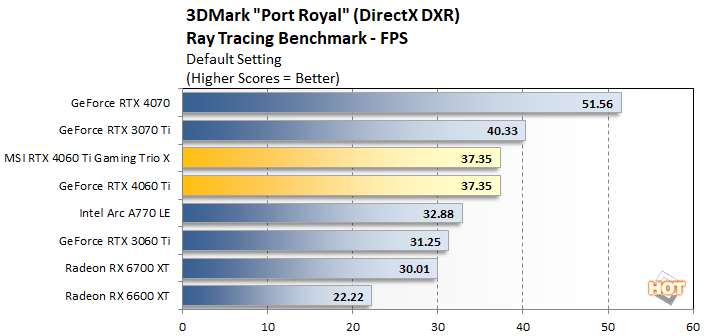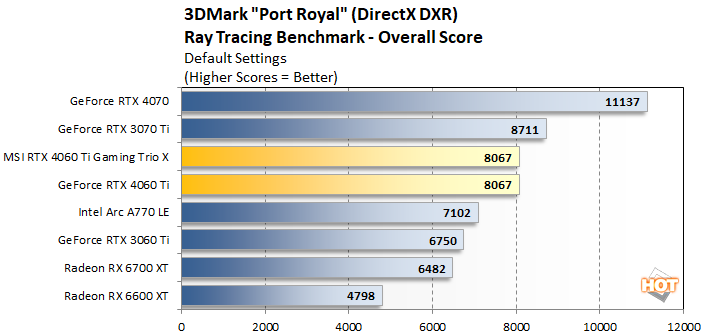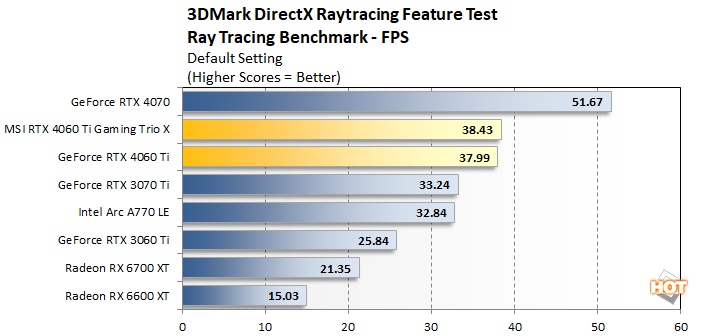MSI GeForce RTX 4060 Ti Gaming X Trio Review: Burly And Brisk
MSI GeForce RTX 4060 Ti Gaming X Trio: UL 3DMark Synthetic And VR Benchmarks
Speed Way is the most recent addition to the UL 3DMark graphics test suite. Speed Way uses the DirectX 12 Ultimate API and leverages advanced features like DirectX Raytracing tier 1.1 for real-time global illumination and real-time raytraced reflections, Mesh Shaders, and high resolution textures and artwork…
Not much to see here if you read yesterday's review, although that's arguably a good thing. The two little Ada cards that could put up practically identical scores—actually identical, in the case of the Graphics score.
Port Royal is nearly a pure GPU test and is extremely sensitive to the ray-tracing compute ability of the graphics card. It's only natural, then, that the GeForce RTX 4060 Ti comports itself rather well in this benchmark, nipping at the heels of the previous-generation yet higher-tier Geforce RTX 3070 Ti card.

DirectX Ray Tracing Feature Test
Unlike Port Royal, this test is solely focused on DXR performance and showcases the strength of Ada's newer RT cores. Here, the GeForce RTX 4060 Ti cards are able to overtake the GeForce RTX 3070 Ti as well as all of the competitors' cards. Though again, the RTX 4070 offers significantly more performance.
In UL's VR test, the Arc card ends up back where we would expect it to be. On the other hand, the GeForce RTX 4060 Ti cards put up a more convincing demonstration against the competition, particularly the last-gen Geforce RTX 3060 Ti. The MSI Gaming X Trio card continues to be fundamentally identical in performance to the reference model.
UL 3DMark Speed Way DX12 Ultimate Benchmarks
Given this benchmark's emphasis on ray-tracing, it's no surprise that the GeForce GPUs leap out ahead of their competition. The GeForce RTX 4060 Ti cards don't gain a lot over the last-gen part, but the Founders Edition model keeps up its curious trend of slightly outpacing the AIB model we're testing today.
UL 3DMark Time Spy DX12 Benchmarks
3DMark Time Spy is a synthetic DirectX benchmark from UL. It features a DirectX 12 engine built from the ground up to support bleeding-edge features like asynchronous compute, explicit multi-adapter, and multi-threading. Time Spy is designed to test the DX12 performance of the latest graphics cards using a variety of techniques and varied visual sequences. This benchmark was developed with input from AMD, Intel, Microsoft, NVIDIA, and the other members of the UL Benchmark Development Program to showcase the performance and visual potential of graphics cards driven by close-to-the-metal, low-overhead APIs.Not much to see here if you read yesterday's review, although that's arguably a good thing. The two little Ada cards that could put up practically identical scores—actually identical, in the case of the Graphics score.
UL 3DMark Port Royal Ray Tracing Benchmarks
Port Royal was released as an update to UL’s popular 3DMark suite. It is designed to test real-time ray tracing performance of graphics cards that support Microsoft DirectX Raytracing, or DXR. Although DXR is technically compatible with all DX12-class GPUs, the graphics card must have drivers that enable support for the feature.
DirectX Ray Tracing (DXR) Feature Test
We also tested the cards with UL's DirectX Ray Tracing Feature test. This test is laser-focused on path-tracing performance, and uses few of the card's other resources.
DirectX Ray Tracing Feature Test
VR Benchmarks: VR Mark & Unigine Superposition
Superposition is the latest benchmark from Unigine, powered by the UNIGINE 2 engine. It offers an array of benchmark modes, targeting gaming workloads as well as VR, with both DirectX and OpenGL code paths. There is an extreme hardware stability test built-in too. Unigine Superposition uses the developer’s unique SSRTGI (Screen-Space Ray-Traced Global Illumination) dynamic lighting technology along with high quality textures and models to produce some excellent visuals. We ran Superposition's VR Future benchmark to compare the performance of all of the graphics cards featured here.
Unigine Superposition VR Future Test

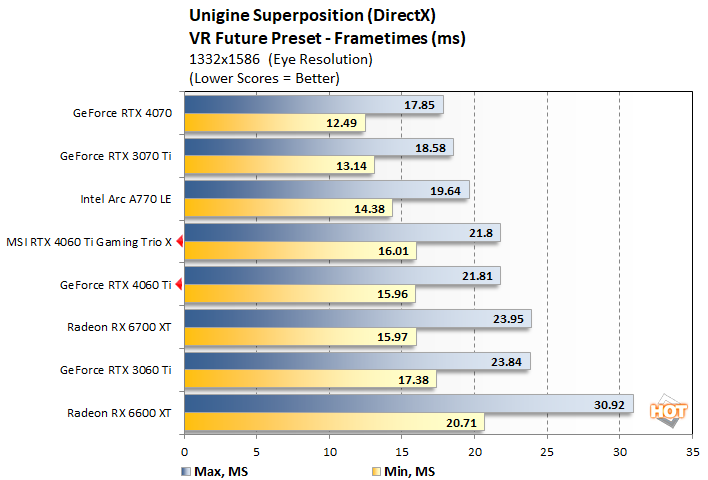
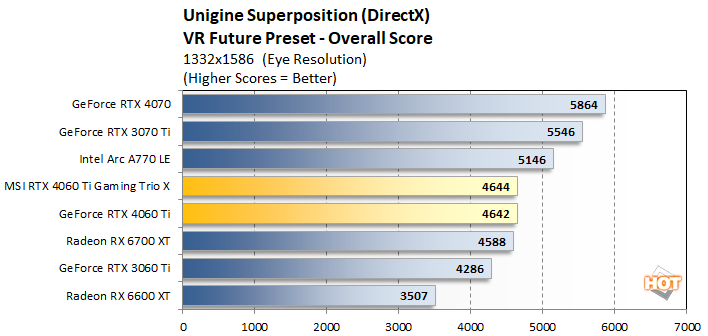
UL VR Mark Blue Room Benchmarks
UL's VRMark is designed to test a PC’s readiness for the HTC Vive and Oculus Rift virtual reality headsets. The benchmark does not, however, require that one of the headsets is attached to the PC to run and it uses an in-house graphics engine and content to ensure comparable results between different platforms. We ran the "Blue Room" VRMark test at defaults settings here, which is currently the most taxing test offered by the tool.In UL's VR test, the Arc card ends up back where we would expect it to be. On the other hand, the GeForce RTX 4060 Ti cards put up a more convincing demonstration against the competition, particularly the last-gen Geforce RTX 3060 Ti. The MSI Gaming X Trio card continues to be fundamentally identical in performance to the reference model.


